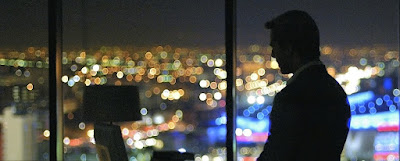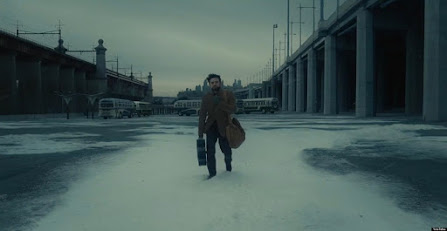Michael Mann and Death
There are two filmmakers that have influenced not just the way I write but the way I indulge in art. Those two are Michael Mann and Douglas Sirk. Very similar filmmakers I know but let that be an insight into my brain for you all.
For a long time, I’ve tried to write what it is about Michael Mann that really just sticks for me, but I think it would be significantly easier if I just talk about a couple of scenes and why I think they’re so important to Mann’s style.
I’ll be discussing in varying degrees of depth Mann’s films so here is your spoiler warning.
One of Michael Mann’s biggest interests in his film is the loss of human life. It’s almost always violent and rather unceremonious, but a certain amount of respect must be paid to that end of life regardless of the person. Two great examples of this can be found in Collateral and Public Enemies.
In the former, we follow a wave of entropy in human form with Tom Cruise’s character, Vincent, going from hit to hit taxi’d, quite literally, by Jamie Foxx’s character Max.
The movie is an absolute visual feast. Never have I seen LA look the way it does in Collateral. The city feels huge and each part of the city they travel to feels so disconnected. A lot can be said about Mann’s visual stylings and I don’t have quite the technical vocabulary to tell you how his movies look the way they do. All I know is that the very real texture his movies have is something I think about probably every day.
Back to Collateral.
The warpath that Vincent carves through the lonely alleys of LA is soon found by LAPD Narcotics Detective Ray Fanning played by Mark Ruffalo. Ray is your classic gumshoe detective. He can put the pieces together before the pieces even completely show themselves.
A man like that no longer belongs in this world.
Vincent and captive Max head into a jazz bar. Vincent smooth talks himself into speaking with the lead trumpet player. They have this amazing conversation that genuinely seems like they’re on their way to becoming friends. The trumpet player regales them with a story about Miles Davis. Vincent is utterly enthralled by someone who’s lived a life where their biggest moment is enjoying the life of another.
Then Vincent kills him.
Three shots from a silenced pistol end every single story this man has spills out in a pool of blood in an empty jazz bar.
Eventually, the paths of Ray, Vincent, The FBI, and Max all converge in a busy nightclub. Vincent passes a sea of people while actively killing people. Just a sea of atoms bumping into each other that can’t even begin to notice when Vincent starts violently killing people. All hell breaks loose as the FBI team starts shooting and that triggers a different set of people shooting.
It doesn’t really matter whos shooting instead what matters is how quickly things can escalate to abrupt chaos.
Vincent kills his mark but in the chaos, Ray finally gets to Max and says he’s here to help. The movie feels like it’s about to take a turn like the rest of the movie is going to be Ray and Max teaming up trying to stop Vincent from killing the rest of his list. But, we all know that that’s not what happens.
Vincent shoots Ray three times as he’s leaving the nightclub and leaves him dead in a doorway.
All of Ray’s experiences and detective skills now lay in a pool of blood outside some nightclub he hadn’t heard of before this very night probably. He dies brutally and totally unceremoniously.
In Public Enemies, we see the death of not just countless bank robbers and cops but the death of an image. With the death of Johnny Dillinger, it’s the death of this sort of gentleman criminal, and with his death, it’s the birth of the modern police state.
In stark contrast to all of his other films, the deaths of characters in Public Enemies are really felt in both the emotional sense and the intellectual sense. There’s a line I really love in this movie spoken by Jason Clark’s character Red. He says “When your time is up it’s up, and I feel like my time is coming up.”
He knows that this way of life is on the way out. To quote a different Michael Mann movie guys like him are in short supply now. For better or for worse.
In the latter half of the film, Dillinger’s friends are dropping like flies. Getting killed in shootouts or being arrested. Their time is running out and every friend shot or thrown in jail is another set of walls closing in on Dillinger. Even if this movie wasn’t based on the real-life of Johnny Dillinger we all know how this would end. Dillinger is shot by three FBI agents and dies facedown and mutters one final statement of rebellion.
FBI agent Winstead, played by Stephen Lang, leans down to hear him but tells his commanding officer that it was just nonsense. Directly after that Winstead visits Dillinger’s lover Billie Frechette in prison. She thinks he’s here to gloat about killing her lover. To shove his death in her face and remind her that the life that they were building together is ashes and was never going to last.
Instead, he tells her Dillinger’s final words to her. “Bye-bye birdie.”
Death is the ultimate equalizer between men like this, and a mutual respect must be paid. It’s a really beautiful scene that makes me very emotional. Part of what makes it so affecting for me is how Mann treats death in all of his other films. It usually happens in an instant and, like the characters, we’re forced to forget and move on. He gives the death of Dillinger and level of respect that almost universally is missing from his other characters.
Mann often gets called a “style over substance” guy which I think is just blatantly false. He cares about the micro parts of a relationship so much that he makes the emotional climax of a star-studded crime thriller about a saying between lovers. He really is such a rarity in the current sea of film and we have to value him while he is still working.
Thanks for reading.



Comments
Post a Comment